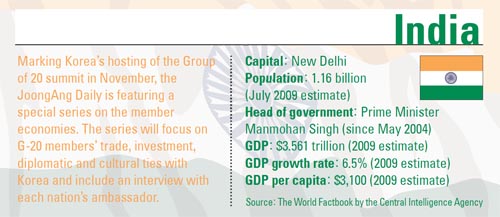Going beyond tariffs and trade volumes

But the scene at a Hindu temple in Yongsan, central Seoul, couldn’t have been more colorful.
In a celebration for Holi, the Festival of Colors, Koreans and Indians alike hurled colored powder and water at each other, throwing their class, gender and age out the window.
Before long, it became impossible to tell an Indian from a Korean.
This raucous scene captured aptly the atmosphere of growing Korean-Indian relations.
In a January summit meeting in New Delhi, Korean President Lee Myung-bak and Indian Prime Minister Manmohan Singh agreed to elevate their ties to a “strategic partnership,” under which the two nations would be linked by a comprehensive bond covering politics, diplomacy, security and culture.
Their bilateral relations have recently been detailed in the Comprehensive Economic Partnership Agreement, which came into effect this year. Essentially a free trade agreement, the CEPA is expected to more than double the countries’ bilateral trade in the next five years.
But their relations go beyond tariffs and trade volumes.
According to the Foreign Ministry here, Korea and India established formal diplomatic relations in 1973. Even without official ties, India still dispatched more than 600 medics to the Korean War in 1950. After the signing of the armistice that halted the war in 1953, India operated a custodian force of more than 6,000 troops to supervise war prisoners until spring of 1954.
Korea opened its consulate general in New Delhi in 1962; India set up its consulate general in Seoul six years later. The Korean consulate general in New Delhi has since been upgraded to an embassy and a new consulate general has been built in Mumbai. Through consistent personnel exchanges over the ensuing decades, the two countries have gradually raised the level of their partnership.
More and more Koreans are taking interest in Indian culture, cuisine and Bollywood films.
The Indian Embassy in Hannam-dong, central Seoul, holds free screenings of Bollywood flicks every last Saturday of the month. Korean fans of the Indian films have formed a group called “Inyoungsamo,” which means “the group of people who love Indian films.” Founded in December 2001, it currently has 11,600 members and holds a separate screening at the embassy once a month. The sessions have grown so popular that the group now only serves 60 members on a first-come, first-serve basis.
Indian restaurants have become trendy spots across Seoul, offering a wide range of cuisine from curry and tandoori chicken to the yogurt-based beverage lassi.
The Cheonggye Stream Museum in Majang-dong, eastern Seoul, in February held an exhibition of Indian folk paintings of the country’s legends.
The annual International Indian Film Academy Awards, held in different countries around the world to celebrate and honor Indian films, will make its stop in Seoul this June.
More than 15,000 Indian movie stars, film industry figures and journalists will make the trip. Korea Tourism Organization officials said hosting the festival has proven to be a boon to tourism for past host cities.
Korea and India are also working on expanding their nuclear cooperation. Lee and Singh signed a civil nuclear agreement in January and the deal will open the Indian nuclear energy market to Korean companies.
India operates 17 nuclear reactors and plans to build 40 by 2032.
Ahead of the summit, India’s Nuclear Power Corp. and the Korea Electric Power Corp. had preliminary discussions on ways to solidify their ties.
As the first step toward bilateral nuclear cooperation, six engineers from India’s Bhabha Atomic Research Centre took a four-day visit to Korea in February. One stop was the Gori nuclear power plant in Busan. The Indian delegation also met with researchers from Kepco, the Korea Atomic Energy Research Institute and Korea Nuclear Fuel Co. The countries are seeking to expand personnel exchanges in the nuclear field.
Korea, which in December last year signed a deal to build reactors in the United Arab Emirates, looks to increase such exports to potential markets, including India.
By Yoo Jee-ho [jeeho@joongang.co.kr]










with the Korea JoongAng Daily
To write comments, please log in to one of the accounts.
Standards Board Policy (0/250자)